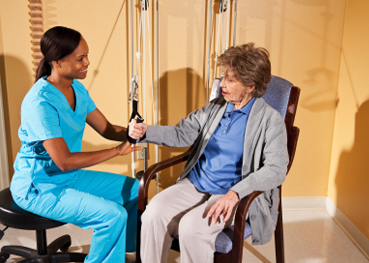
Resident care would suffer and providers would shoulder a larger burden if Congress acts on the latest recommendations from the Medicare Payment Advisory Commission, advocates for the long-term care sector say.
MedPAC devoted a chapter of its June 2013 Congressional report to outpatient therapy, laying out a series of recommendations that sparked sharp concern from the long-term care sector. These recommendations include lowering the yearly cap on combined physical and speech-language therapy from $1,900 to $1,270. A separate $1,900 cap for occupational therapy should also be reduced to $1,270, MedPAC recommended.
Both the American Health Care Association and the National Association for the Support of Long-Term Care spoke out against these proposals. NASL advocated for “repeal of the therapy cap and development of a new payment system that would reflect the key factors around clinical diagnosis of the patient and complexity of rehabilitative treatments and episodes.”
MedPAC offered “dire, scary recommendations,” Cynthia Morton, NASL executive vice president, told McKnight’s.
AHCA President Mark Parkinson called for more data-driven decision making, saying the latest recommendations are “short-sighted” due to a lack of “consistent guidelines which produce data demonstrating the improved outcomes therapy services provide.”
The proposed changes would impact skilled nursing facilities in particular, which accounted for 37% of Medicare therapy-related reimbursements in 2011, according to the report. Providers are concerned that the process of obtaining manual approval for medically necessary therapy that exceeds the caps will erode quality of care while adding a bureaucratic burden. Reducing therapy reimbursements would also cut into SNFs’ already tight margins.
MedPAC sought to address this concern by proposing a streamlined approvals process for exceptions to the cap, which would allow providers to submit requests electronically for the first time. The system would also allow beneficiaries two therapy visits during a 10-day window while the manual review is pending. The provider would be liable for the cost of these sessions if the therapy was deemed medically unnecessary.
These proposals are a “good start,” NASL’s Morton said, adding that MedPAC has listened to input. But she cautioned that “electronic” is vague language, and reviewers are not likely to accept PDFs containing personal health information. With the therapy cap at $3,700, manual reviews were so delayed that CMS had to revamp the system, Morton pointed out. If the caps are reduced to $1,270, the number of reviews could triple.
“There’s no reviewing entity that could handle that workload in ten days,” she said. “It’s an unworkable recommendation that does not keep the patient at the forefront.”
MedPAC’s review of outpatient therapy was mandated by the Middle Class Tax Relief and Job Creation Act of 2012, and some recommendations in the current report were released — and adopted by the Centers for Medicare & Medicaid Services — last year.




